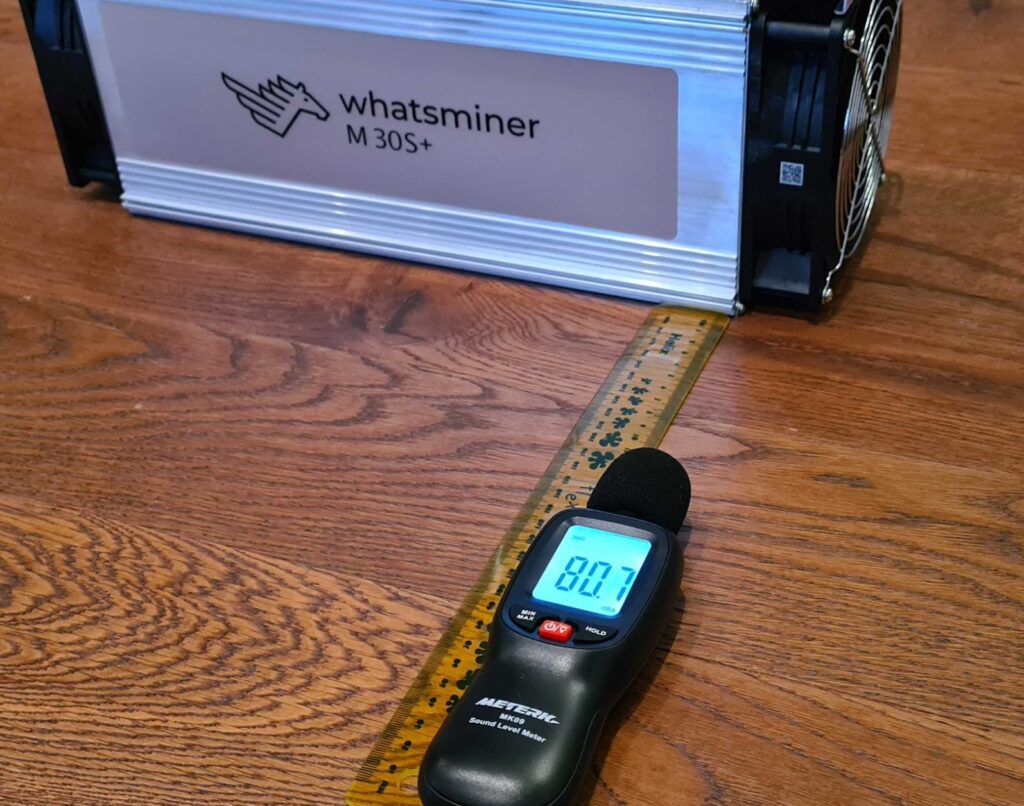Abstract: We compare and measure various performance metrics for two of the latest and most energy efficient Bitcoin mining products, MicroBT’s Whatsminer M30S+ and Bitmain’s Antminer S19 Pro. Obviously the more expensive 7nm Bitmain product is more powerful, however the miners are pretty similar in terms of output. Our data over a short three day period shows that the Bitmain miner has slightly stronger performance than the Whatsminer, however the Whatsminer appears to have superior stability. In general, both machines are impressive and we predict the two companies will be in neck and neck competition over the next few years.

Overview
Following on from our June 2020 piece, the “Battle For ASIC Supremacy”, in this report we dive into the details of the flagship products from two of the leading ASIC manufacturing contenders. MicroBT’s Whatsminer M30S+, available for US$1,580 and Bitmain’s Antminer S19 Pro, with a list price of US$2,407. It should be noted that the Whatsminer M30S+ is not MicroBT’s latest product and a more efficient Whatsminer M30S++ has now been released. In this report we experimented with the two products, running each miner for three days and recording various performance metrics, such as the hashrate, power usage, temperature, sound level and even the air flow speed from the main outlet.
Hashrate
Bitmain’s S19 Pro has a reported hashrate of 110 TH/s, while the Whatsminer M30S+ can reportedly generate 100 TH/s. This is an incredible amount of hash attempts for one machine, over 100 trillion attempts at finding Bitcoin’s block hash per second. As Figure 1 below illustrates, in the period both miners achieved a hashrate around their respective target level.
The Whatsminer M30S+ achieved an average hashrate of 98.1 TH/s, 1.9% below the advertised level, while Bitmain’s S19 Pro fared slightly better, achieving 110.7 TH/s, 0.6% above the advertised figure. As the chart also indicates, the Whatsminer obtained a more stable hashrate, with a variance of about half that of Bitmain’s product in the period. We consider this stability a significant factor in favour of the Whatsminer.
After upgrading the Whatsminer M30S+ to the latest firmware, it produced hashes at a rate of 103.3 TH/s, above the advertised rate. This is based on an average over a six hour period.
Figure 1 – Miner Hashrate (TH/s)
(Source: BitMEX Research)
(Notes: Hashrate data from miner control panel)
Figures 2 and 3 below demonstrate the hashrate for each miner as reported by the mining pool, based on 15 minute windows. Based on these figures over the same three day period, the average hashrates were the same, 98.1 TH/s for the Whatsminer and 110.7 TH/s for the Antminer.
Figure 2 – Whatsminer M30S+ Pool Reported Hashrate (TH/s)
(Source: BitMEX Research, Poolin)
Figure 3 – Antminer S19 Pro Pool Reported Hashrate (TH/s)
(Source: BitMEX Research, Poolin)
Energy efficiency
As Figures 4 and 5 below indicate, when it comes to energy efficiency, both products performed well, in line with the advertised figures. In the period the Whatsminer used an average of 34.4 J/TH, 1.0% above the advertised figure of 34 J/TH. The Antminer fared slightly better, it used an average of 29.7 J/TH, 0.6% above the advertised rate.
Figure 4 – Whatsminer M30S+ Mining Efficiency (J/TH)
(Source: BitMEX Research, Poolin)
(Notes: Power output measured by a wattmeter)
Figure 5 – Antminer S19 Pro Mining Efficiency (J/TH)
(Source: BitMEX Research, Poolin)
(Notes: Power output measured by a wattmeter)
Whatsminer High Power Mode
The Whatsminer M30S+ also has an option of a “high power” mode, which we experimented with for one day. As Figure 6 below shows, during this period the miner produced an average output of 109.4 TH/s, a significant increase compared to “normal power” mode. Of course this also consumes more power, 3,743 W, compared to 3,331 W in normal conditions.
Figure 6 – Whatsminer M30S+ Pool Reported Hashrate (TH/s) – High Power Mode
(Source: BitMEX Research, Poolin)
In high power mode the Whatsminer had marginally better energy efficiency, with an average rate of 34.3 J/TH.
Figure 7 – Whatsminer M30S+ Mining Efficiency (J/TH) – High Power Mode
(Source: BitMEX Research, Poolin)
Temperature
One of the most significant differences between the devices, in Bitmain’s favour, is the average temperature of the miners. We measured the temperature every hour, by placing an electronic thermometer 15cm away from the main air outlet, directly in the air stream. The Antminer was on average 45.9°C, around 10.5°C cooler compared to the Whatsminer. We consider this a significant difference, in favour of the Antminer. This may be due to the Antminer’s lower power consumption or superior cooling in the Antminer, which has more fans and generates a higher air flow speed. In addition to the Whatsminer air flow temperature being considerably warmer than the Antminer, the Whatsminer device itself was also significantly hotter in the period.
Figure 8 – Miner Temperature (°C)
(Source: BitMEX Research)
(Note: Temperate measured 15cm away from the miner, directly in the air flow outside the main exhaust)
Sound
We also measured the level of noise generated by each machine, by placing a sound meter 15cm away from the miner, in a direction perpendicular to the main air flow. The Whatsminer was the lounder machine, generating an average sound of 83.0 dB, compared to the Antminer with 81.4 dB. As Figure 9 below illustrates, the Whatsminer was far more stable, with the Antminer sound varying almost four times as much as the Whatsminer. This is a reasonably similar story to the hashrate, where the Antiminer performs slightly better, but the Whatsminer has superior stability. It will be interesting to see if this means that the Whatsminer proves to be more resilient over the long term.
Figure 9 – Miner Volume (dB)
(Source: BitMEX Research)
(Note: A sound meter was placed 15 cm from the miner, perpendicular to the fan outtake)

Air Speed
In what admittedly is probably the least useful metric in this report, we measured the air flow speed. Based on an average of ten readings, one hour apart, the Antminer generated an average speed of 5.2 m/s, compared to the Whatsminer with 3.0 m/s.
Figure 11 – Miner air flow speed (m/s)
(Source: BitMEX Research)
(Note: Air speed measured 15cm away from the miner, directly in the air flow outside the main exhaust)

Start-up time
A key area where we found the Antminer to be stronger is the boot time. Based on an average of five attempts, the Antminer reached its target hashrate in around four minutes, while the Whatsminer took an average of around 27 minutes to boot up. However, this may be due to a safety feature in the Whatsminer.
Figure 10 – Time for miner to reach target hashrate (minutes)
(Source: BitMEX Research)
(Note: Average of five attempts)
Logistics and supply chain
One key area where MicroBT is currently excelling compared to Bitmain, is supply chain management. If one wants to buy one of these miners now, there simply is no choice, the Antminer is not currently available for sale. We have spoken to numerous Bitmain clients who have complained about repeated shipment delays and warehouse problems. We even faced this problem ourselves, MicroBT was able to deliver the product in a few days, while Bitmain took almost five weeks, often blaming warehouse problems. The cause of this could be that TSMC’s 7nm chips have supply issues combined with the ongoing power struggle at Bitmain, which is said to be impacting the logistics network.
Conclusion
The first thing to note is that the Antminer S19 Pro is simply a better more energy efficient machine, achieving 29.7 J/TH, far lower than the Whatsminer on 34.4 J/TH. However, MicroBT has already launched a newer product, available for sale now, the M30S++, with a reported efficiency of 31.0 J/TH. This is still inferior to Bitmain, however it is pretty close, especially considering Bitmain uses a higher performance 7nm TSMC chip, compared to MicroBT using a lower performance 8nm Samsung chip. It should also be noted that the MicroBT products are far cheaper and crucially, available now, while Bitmain’s products are sold out according to the Bitmain website.
In evaluating the relative strength of the companies and their order outlook, Bitmain still has the slight edge in our view. Primarily driven by Bitmain’s superior brand and name recognition. We have spoken to several mining farm operators and while they are typically highly frustrated by Bitmain’s supply chain issues, many of them are keen to stick to Bitmain without even considering MicroBT. It is also very difficult to get a mining farm operator to switch, as sticking to one manufacturer improves operating efficiency and reduces maintenance costs.
As for the products themselves, based on the data in this report, we would conclude the companies are neck and neck, or perhaps, when considering everything, Bitmain still has a miniscule lead.
Disclosure
MicroBT provided us with the Whatsminer M30S+ as a free gift, while Bitmain let us borrow the Antminer S19 Pro for three weeks.
Related
The post appeared first on Blog BitMex






